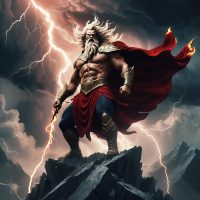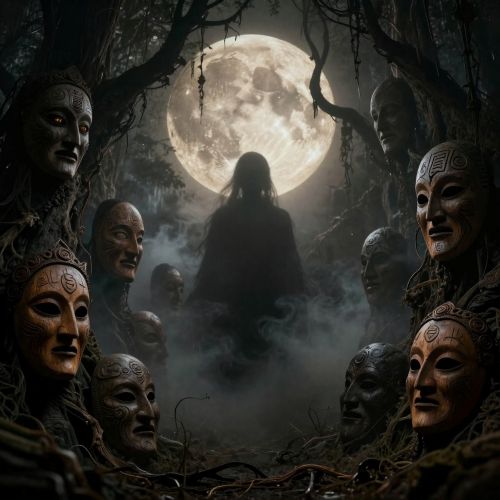Theshxwe : The Thunder God
Listen
At a glance
| Description | |
|---|---|
| Origin | Circassian Mythology |
| Classification | Gods |
| Family Members | Tlepsh (Father), Sosruko, Pataraz (Brothers) |
| Region | Russia |
| Associated With | Thunder, Lightning |
Theshxwe
Introduction
Theshxwe, also spelled Teshxue or Teshkho, is one of the most revered deities in Circassian mythology, representing thunder, lightning, and divine justice. Worshipped among the Adyghe people of the North Caucasus, he stands as a central figure in the Nart sagas—the legendary epic cycle that defines Circassian folklore and cultural identity. Theshxwe’s thunderous might and fiery temperament made him a symbol of both fear and reverence. Much like Thor in Norse mythology or Perun in Slavic tradition, he embodies the raw forces of nature and moral order, ensuring that justice prevails across both the divine and mortal realms. His name itself is derived from the Adyghe root “tesh,” meaning “thunder,” emphasizing his celestial dominion and elemental authority.
As the bringer of storms and the guardian of truth, Theshxwe holds a unique position in the Circassian pantheon. He is both a destroyer and a protector—punishing injustice while safeguarding the virtuous. His role in myth reflects the deep connection between the Circassians and their rugged, mountainous homeland, where the power of storms was seen as an extension of divine will.
Physical Traits
In the oral traditions of the Caucasus, Theshxwe is depicted as a towering and formidable warrior whose presence commands awe. His body glows with the intensity of molten metal, radiating heat and light like the heart of a thunderstorm. His eyes flash with lightning, and his voice echoes across valleys as the sound of rolling thunder. Often, storytellers describe him wielding a blazing whip or a thunderbolt, forged by the divine smith-god Tlepsh, which he hurls to strike down liars, cowards, and those who disrupt harmony.
Legends also speak of Theshxwe riding through the storm clouds on a celestial steed, its hooves sparking fire as it gallops across the heavens. This imagery links him to both the destructive and purifying powers of the storm. The spectacle of lightning splitting the sky was believed to be the visible sign of his wrath, while the ensuing rain symbolized his mercy, replenishing the earth after punishment had been served.
Family
Within Circassian mythology, Theshxwe belongs to the divine family of the Narts—a pantheon of semi-divine beings who embody heroism, virtue, and cosmic law. His lineage varies across regional traditions, but many myths identify him as the son of Tlepsh, the god of fire and craftsmanship. This divine connection highlights Theshxwe’s command over both elemental and creative forces, suggesting that thunder and fire are two sides of the same sacred power.
His siblings are equally significant in Circassian myth. Sosruko, the trickster-hero known for his cunning and agility, often interacts with Theshxwe in tales where wit must balance strength. Pataraz, the god of war and justice, is sometimes portrayed as Theshxwe’s brother or companion, fighting alongside him in battles that shape the moral and natural order. This divine family represents the harmony of fire, thunder, wisdom, and courage that underpins Circassian spirituality.
Theshxwe’s position among them is that of enforcer and judge—he who ensures that divine decrees are upheld, whether among gods, heroes, or mortals.
Other names
Theshxwe’s name appears in several variations depending on dialect and oral tradition, including Teshxue, Teshkho, and Theshkhew. Despite these differences, all names share the same linguistic root associated with thunder and storm. The multiplicity of spellings reflects the widespread worship of this god across different Circassian tribes and their diasporic descendants.
In certain later adaptations influenced by Abrahamic religions, Theshxwe was occasionally syncretized with archangelic or warrior figures, reflecting cultural shifts while retaining his original character as a thunder deity. Among his epithets are “The Thunderer of the Peaks,” emphasizing his dominion over the mountains; “Flame of the Sky,” highlighting his fiery essence; and “Wrath of the Narts,” symbolizing his role as divine avenger. These titles capture both the physical might and moral authority that defined his worship.
Powers and Abilities
Theshxwe’s powers encompass control over the natural and spiritual realms. As the god of thunder and storms, he commands lightning, wind, and rain. He can summon tempests to punish the wicked or cleanse the land of corruption. His thunderbolts, crafted by Tlepsh, are imbued with divine fire and moral intent—each strike a symbol of justice delivered by divine hand.
In the Nart sagas, Theshxwe often intervenes during times of conflict, using his power to decide the fate of heroes and nations. His role extends beyond destruction; he restores order after chaos, much like the calm that follows a storm. Myths depict him as a divine judge whose decisions are final and absolute. When invoked in rituals, he is called upon to bring truth to light and grant strength in battle.
Theshxwe’s influence is also moral and psychological. He embodies courage, integrity, and the unwavering pursuit of justice. Those who lived in accordance with his principles were said to gain his protection, while those who acted deceitfully faced his wrath. The balance he represents—between punishment and renewal, fury and compassion—mirrors the natural balance of the world itself.
Modern Day Influence
Although traditional Circassian paganism diminished under the influence of Islam and Christianity, Theshxwe remains deeply embedded in Circassian cultural consciousness. His stories endure through oral epics, folk songs, and traditional dances performed in the North Caucasus and among diaspora communities in Turkey, Jordan, and beyond. These performances are not merely artistic but serve as acts of cultural preservation, ensuring that ancient beliefs remain alive within modern identity.
In contemporary times, Theshxwe has found renewed life through neo-pagan movements and academic interest in Caucasian mythology. He symbolizes ethnic pride, resistance, and the enduring bond between humanity and nature. His thunderous image is celebrated in literature, visual art, and even modern digital media such as video games exploring ancient mythological worlds. Scholars studying comparative mythology often draw parallels between Theshxwe and Indo-European thunder gods like Zeus, Thor, and Indra, recognizing shared archetypal themes of power, justice, and storm.
Among Circassians in diaspora, Theshxwe’s legend plays an important role in reconnecting younger generations to their ancestral roots. Online platforms and folklore initiatives are reviving his myths, presenting them in modern formats while preserving their authenticity. The god of thunder has thus evolved into a cultural icon—representing not only divine power but also the indomitable spirit of a people who continue to honor their origins through story and song.
In essence, Theshxwe’s legacy transcends mythology. He embodies the Circassian relationship with nature’s strength and unpredictability, a symbol of moral clarity in turbulent times. His thunder still echoes across the mountains of the Caucasus and through the voices of those who keep his name alive, ensuring that the power of Theshxwe endures in both the storm and the soul.
Related Images
Source
Jaïmoukha, A. (n.d.). Circassian Religion and Beliefs. Retrieved from http://jaimoukha.synthasite.com/resources/Circassian%20Religion.pdf
“Circassian paganism.” (2021, April 16). In Wikipedia. Retrieved October 2025, from https://en.wikipedia.org/wiki/Circassian_paganism
“Cherkess Mythology.” (n.d.). Folklore.Earth. Retrieved from https://www.folklore.earth/culture/cherkess/
Asfar, U.K. (2021, January 26). The Mythological and Cultural Traces of the Caucasian Folklore. Retrieved from https://asfar.org.uk/the-mythological-and-cultural-traces-of-the-caucasian-folklore/
Colarusso, J. (n.d.). Prometheus among the Circassians. Retrieved from http://johncolarusso.net/pdf/Prometheus_among_the_Circassians.pdf
Circassian Identity Blog. (n.d.). Religions and Beliefs. Retrieved from http://circassianidentity.blogspot.com/p/circassian-religoin-and-belief.html
Grafiati. (2024, July 30). Journal Articles: Caucasian Mythology. Retrieved from https://www.grafiati.com/en/literature-selections/caucasian-mythology/journal/
Circassian World. (n.d.). RETURN OF THE CIRCASSIAN WORLD: MAY THE FORCE BE WITH YOU. Retrieved from https://www.circassianworld.com/pdf/ReturnoftheCircassianWorld.pdf
Chirikba, V. (2010). Caucasian Mythologies and Comparative Indo-European Studies. Caucasus Journal of Social Sciences, 5(2), 45–67.
Smeets, R. (2015). Adyghe Oral Traditions and the Nart Epics. Journal of Caucasian Studies, 3(1), 22–39
Frequently Asked Questions
What is lorem Ipsum?
I am text block. Click edit button to change this text. Lorem ipsum dolor sit amet, consectetur adipiscing elit. Ut elit tellus, luctus nec ullamcorper mattis, pulvinar dapibus leo.
What is lorem Ipsum?
I am text block. Click edit button to change this text. Lorem ipsum dolor sit amet, consectetur adipiscing elit. Ut elit tellus, luctus nec ullamcorper mattis, pulvinar dapibus leo.
What is lorem Ipsum?
I am text block. Click edit button to change this text. Lorem ipsum dolor sit amet, consectetur adipiscing elit. Ut elit tellus, luctus nec ullamcorper mattis, pulvinar dapibus leo.
What is lorem Ipsum?
I am text block. Click edit button to change this text. Lorem ipsum dolor sit amet, consectetur adipiscing elit. Ut elit tellus, luctus nec ullamcorper mattis, pulvinar dapibus leo.
What is lorem Ipsum?
I am text block. Click edit button to change this text. Lorem ipsum dolor sit amet, consectetur adipiscing elit. Ut elit tellus, luctus nec ullamcorper mattis, pulvinar dapibus leo.





